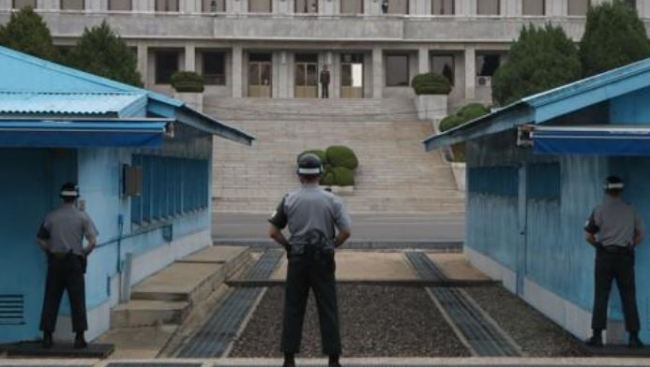A 140-member North Korean art delegation that will attend next month's PyeongChang Winter Olympics is likely to walk across the tense border, where a soldier made a dramatic defection to the South two months ago while sustaining gunshot wounds, officials said Tuesday.
South Korea said Monday that the North has requested that its performers be allowed to cross the border at the truce village of Panmunjom when it visits the South for concerts during the Winter Olympics.
After inter-Korean talks, North Korea agreed to send the band, including an 80-member orchestra, singers and dancers, to perform in Seoul and Gangneung, 240 kilometers east of the capital, according to Seoul's unification ministry.
The government needs to consult with the United Nations Command for their rare massive border-crossing trip.
The shared border village is located inside the heavily fortified Demilitarized Zone, the 2.5-mile wide strip of land separating the two Koreas.
 |
This file photo shows the truce village of Panmunjom inside the heavily fortified Demilitarized Zone (DMZ) that bisects the two Koreas. (Yonhap) |
South and North Korea still remain technically at war since the 1950-53 Korean War ended in a truce, not in a peace treaty. Panmunjom is the venue where the Armistice Agreement was signed.
In November, it was the place where the North Korean solider, surnamed Oh, was shot and wounded by his comrades when he sought to cross the border for defection.
Experts said that if the North's art troupe comes to the South on foot through the truce village, the move could have a symbolic meaning of reconciliation between the two Koreas.
"North Korea would want to show to the world that the trip through Panmunjom, the symbol of confrontation, heralds the opening of fresh inter-Korean reconciliation," said Cheong Seong-chang, a senior research fellow at the Sejong Institute.
Since 2000, the two Koreas had used two land routes in the western and eastern parts for civilian movement and transportation of goods.
One of them is a route leading to the now-shuttered inter-Korean industrial park in the North Korean border city of Kaesong. A checkpoint leading to the complex is located in Paju, north of Seoul.
Seoul closed the Kaesong Industrial Complex in February 2016 in response to North Korea's nuclear and missile tests. In retaliation, the North froze assets and designated it as a military zone.
"North Korea seems to be trying to show that it is a normal state respecting peace through the art troupe's trip via Panmunjom. Its message apparently targets the United States," said Kim Yong-hyun, a professor at Dongguk University.
Kim said that the North probably does not want to use the route linking to the Kaesong complex, the symbol of inter-Korean economic reconciliation, as Seoul closed the factory zone.
Before the roads were opened, Panmunjom was used as the main gateway between South and North Korea.
In 1985, the two Koreas' art troupes reached each other's soil via the truce village for the first time to hold respective performances in Seoul and Pyongyang.
In 1998, Chung Ju-yung, founder and honorary chairman of Hyundai Group, went to North Korea via the truce village to deliver 50 truck loads of 500 cattle to the hunger-stricken North. (Yonhap)








